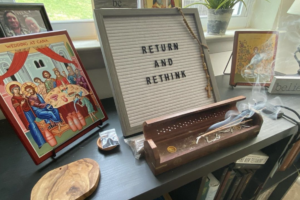
This is a picture of former Trappist monk turned psychotherapist Jim Finley, who was once mentored by the (in)famous Thomas Merton. He is standing in front of Merton’s hermitage at the Our Lady of Gethsemani Abbey in Trappist, Kentucky.
Merton was a Christian mystic in his own right and was deeply influenced by the figures of Augustine, Teresa of Avila, John of the Cross, the early Monastics, and so on.
Without a doubt, both Merton and Finley have had a profound influence on my external and internal life over the past ten years. It began with my reading of No Man is an Island and New Seeds of Contemplation by Merton, which kickstarted my eventual reading of everything I could from Merton. From there, I moved on to anything I could find from Finley, and in some ways crescendoed at my own visit to Our Lady of Gethsemani Abbey myself, where I stood over Merton’s grave like some form of spiritual pilgrimage.
I made a video of that trip, and posted it on YouTube here.
Here’s the thing, the contemplative/mystic tradition of Christianity transcends and includes the denominational lines that we draw. The Protestant, Catholic, and Eastern Orthodox Christian contemplative/mystic can all sit together in the same room and feel a sense of family fidelity. The problem is that the contemplative/mystic tradition of Christianity is not taught in conventional churches.
In the average Church, at least in the West, you will largely only hear sermons about what it means to be Christian if it overlaps with what it also means to be an “American.”
As Merton once said, “Many people are losing faith and they are losing it in Church, because the Church is not teaching its own tradition.”
This means that the Church desperately needs figures such as Merton, Finley, Teresa of Avila, John of the Cross, the Cappadocians, the Desert Monastics, the Rhineland Mystics, and the rest to help carry the contemplative/mystic tradition to each new generation.
There truly is a spiritual lineage of the Christian mystics, and it zigs and zags back and forth and all around denominational Christianity.
As someone who has spent a good amount of time in a number of different denominations, I can confidently say that I feel most at home in the contemplative/mystic tradition of Christianity. It asks completely different questions from a completely different starting point, and that feels refreshing to me. Not only that, but it also seems to cut right to the heart of the matter: a mutual-indwelling of God and man, through the burning love of the Crucified one.
I hope to meet Jim Finley one day, at least over Zoom, if not in person. And should that day ever come, I hope to tell him my thanks for helping to carry the spiritual lineage of the Christian mystics to someone like me.


